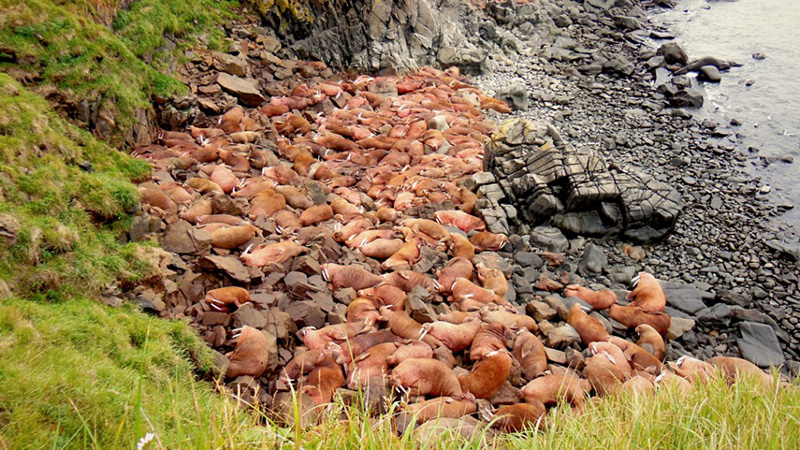Here are a few of the things to look for, and what to do when you see them from Ed Weiss, Lands & Refuge Manager of ADF&G:
Haulout Disturbances. One of the aspects that ADF&G staff monitor while on Round Island are the disturbances that occur to the walrus while on the beach. These disturbances can come from several different natural or man-made sources such as boats, airplanes, approaching humans, Orcas, foxes, ravens, and thunderstorms. If walruses are rushing onto the beach, it’s likely that Orcas are offshore. Other sources usually result in a response which could range from simple head raising to see what the problem is, to getting up and moving or relocating towards the water, or actually leaving the beach. These reactions are further difficult in that they can occur in a relatively slow and orderly fashion; or very fast in a rushed pace or stampede. Information gathered includes the date, times, source, weather parameters, and details on the level of the disturbance. These data are then used to both report disturbances that occur and to determine if management actions are needed to further minimize these disturbances. If you observe one of these disturbances send an email to ed.weiss@alaska.gov with the camera or beach that was being viewed, date and time of disturbance (noting time zone used), and any apparent reason for the disturbance you may have observed.
Wildlife Observations. At any particular time there are many different wildlife observations occurring on camera. While we don’t need to know about every seabird or walrus that comes into view, by recording less common happenings we can build an information base on seasonality of use, habits, ranges of various species that come into view. In general, we don’t need to see observations about the walrus and seabirds that are always in view. If something odd or different is observed such as a sick or seriously injured animal, animals with marine debris wrapped around them, a lot of baby seabirds start fledging, you can help by sending an email to ed.weiss@alaska.gov with some brief information: Date, time (including time zone), location (beach), species, and brief description of what was occurring. We will add these observations to our database which over time gives us a look into species presence and use at Round Island.
Disease, injuries, marine debris. Other useful bits of information from the walrus haulout are observations of diseased, sick, seriously injured animals or animals with marine debris wrapped around them. As with the other observations a simple email to ed.weiss@alaska.gov with: Date, time (including time zone), location (beach), species, and brief description will get us started and we can look at the footage to gain details. In regards to injuries, walruses poke at each other constantly, and do often have a few open sores or bleeding tusks. It’s not necessary to report these. We are looking for more serious cases such as walrus with large open wounds, large infections, or covered in open sores, that might indicate some sort of disease or larger injury.
Together, we hope to use the power of live cams and the community that watches them to make a difference.



